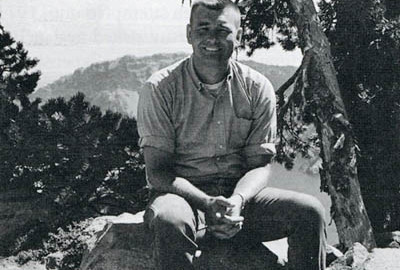Let’s go back to Crater Lake, during that period when I did my dissertation there. I see question 2 here, “What brought Jack Donaldson to OSU?” and “How did he influence your choice of Crater Lake as a study area for your dissertation?”
Jack came to OSU after finishing his doctoral thesis. He studied Lake Iliamna in Alaska and looked at phosphorous from fish carcasses there. Salmon migrating into the lake, they die, their carcasses decay, they release large quantities of phosphorous. He was interested in this part of the nutrient cycle. His dad, of course, was a very famous fish biologist at the University of Washington. Loren, by the way, just recently died at age 95 last year. A job came up at OSU and Jack applied for it. Carl Bond, the fishery biologist at OSU was Jack’s mentor. He, of course, knew Loren and Jack, so he supported Jack’s hiring. There were a couple of other people who had applied from UC Davis. When I got there Jack wasn’t even clear about how he was going to approach this massive project. The first field trip we made was to go to Crater Lake, but I went along with Jack to observe. He went down to monitor Owen’s [Hoffman] progress. He took me out in the boat on that trip in July, 1967. My research didn’t get started there until 1968, the following summer. Owen and Donaldson had done some C-14 in July, 1967, and that was the first profile ever done of the lake. There were other lakes we considered for candidates to compare with Crater.
How much linkage was there at OSU between limnology and oceanography?
None. There was really no limnology program. It was really a fisheries program. In fact my doctorate says fisheries. I know virtually nothing about fish. Limnology was sort of a little field in the Department of Fisheries and Wildlife. I think one of the things that Donaldson was disenchanted with, or demoralized by, was the fact that it wasn’t getting serious consideration as a discipline. I think the Department of Fisheries and Wildlife was an old boy network of guys who liked to hunt and fish. Their idea of research was to
go out and count ducks — a lot of descriptive stuff, but old methods. The only real research scientists there in my opinion were Dr. Charles Warren and Dr. Peter Doudoroff. Those two were doing what I thought was cutting edge research in looking at the effects of reduced dissolved oxygen on fish growth, and behavior, and those sorts of things. I would have loved to be in their program, but I really wasn’t interested in those topics. I was looking for that type of research program in limnology, but it just didn’t exist. I regretted the fact that I went to OSU, but it wasn’t Donaldson’s fault. He was starting the program and his job was to develop it.
How much linkage was there at OSU between limnology and oceanography?
None. There was really no limnology program. It was really a fisheries program. In fact my doctorate says fisheries. I know virtually nothing about fish. Limnology was sort of a little field in the Department of Fisheries and Wildlife. I think one of the things that Donaldson was disenchanted with, or demoralized by, was the fact that it wasn’t getting serious consideration as a discipline. I think the Department of Fisheries and Wildlife was an old boy network of guys who liked to hunt and fish. Their idea of research was to go out and count ducks — a lot of descriptive stuff, but old methods. The only real research scientists there in my opinion were Dr. Charles Warren and Dr. Peter Doudoroff. Those two were doing what I thought was cutting edge research in looking at the effects of reduced dissolved oxygen on fish growth, and behavior, and those sorts of things. I would have loved to be in their program, but I really wasn’t interested in those topics. I was looking for that type of research program in limnology, but it just didn’t exist. I regretted the fact that I went to OSU, but it wasn’t Donaldson’s fault. He was starting the program and his job was to develop it.


